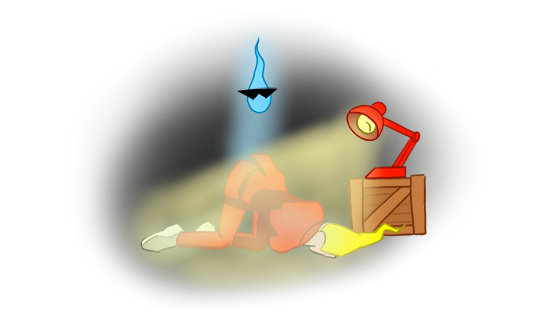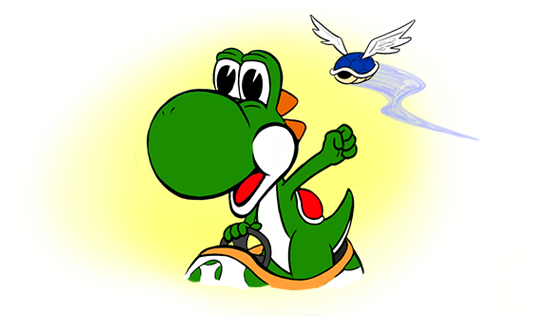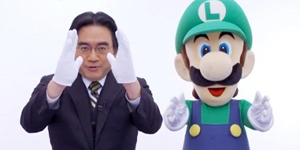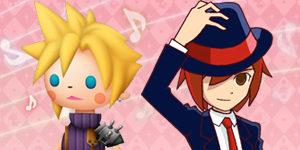Extra: Flashback Vol. 6 – Nintendo DS
The Nintendo DS made quite a name for itself. It brought touch screen gaming to the masses, ushered in a new audience for Nintendo, and ultimately became the best selling portable system of all time. Of course, none of these achievements would have been possible without its huge library of games. We previously examined the system’s history, and now we want to turn our attention to the software itself. Whether you were a core gamer or a casual gamer, a fish in the red ocean or the blue ocean, the DS offered plenty of great content and everyone had their favorites. In this latest edition of Flashback, we each share two of our own favorites with original artwork and retrospectives. Some are system sellers, others are slightly more obscure. The one thing they have in common? They’re all excellent games that are worthy additions to any DS library. Enjoy!

Jose’s Pick: Ghost Trick
From the mind that brought us the amazing Phoenix Wright: Ace Attorney comes a game that stars a protagonist who dies before you even get a chance to control him. No need to worry, the death of this character is only the beginning as this ghost has a lot of tricks up its spectral sleeve. Ghost Trick is a plot-driven puzzle game in the same way that Ace Attorney and Professor Layton are. Instead of courtroom battles and brainteasers, you are tasked with figuring out how to prevent the deaths of characters. As you make your way from environment to environment and meet new (and very animated) characters, you are constantly finding dead bodies or witnessing someone getting killed. Since you are a spirit with special powers, you are able to rewind time to an oddly specific four minutes into the past. It is then that you have to possess objects in order to manipulate the environment and prevent the death of each character before the four minutes are up.
When I first played Ghost Trick, I was coming off of four Ace Attorney games and loved each of them, so I had high expectations for this game. Not only were these expectations met, but they were exceeded as I became a huge fan of the story, characters, and the presentation. Ghost Trick has a unique style all its own that just evokes personality. In addition, the character animation is top notch. Sure a lot of it is over the top, but that is what makes this game so great. It knows when to be silly and when it can take itself seriously. The soundtrack is also wonderful, with its great mood-setting music and some catchy upbeat tunes. Full of twists and great characters (Missile is an awesome dog!), this is definitely a game worth playing. Luckily for many that missed it, Ghost Trick is also now available on iOS, with a free first chapter to boot.

Jose’s Pick: Pokemon Diamond
I have always been a fan of the Pokemon franchise, but I never got into the core Pokemon series until this gem was released. I hadn’t played a single version of Pokemon since Blue, and I was excited to dive into this new DS edition. Yes, the game still had eight gyms to go through, an evil organization to take down, and a few legendaries to catch. What always made a “Pokemon” game was still well intact, but I didn’t get this game for any of those things. All I cared about were the new Pokemon and the updated battle mechanics. It was during my time with Diamond that I learned about the wonders of EV training and competitive team building (even though I usually made themed teams or picked favorites and then built a strategy around that).
Generation 4 of Pokemon, which included Diamond and its Pearl counterpart, was when things really started to evolve for the series. Pokemon that never got much play received evolutions that made them more viable. New moves were also introduced that single-handedly changed how you go about building your team (I’m looking at you, Stealth Rock). Biggest of all, whether an attack is physical or special is no longer simply determined by the moves type. For instance, Hyper Beam was reclassified as a special attack, as it should be considering that it is a beam and not a physical contact move. This game also brought the world of live online battling to players. It may have been only against people on your friend list, but at least the option was there. That also went for trading. One nice option that the developers at Game Freak included was the ability save the data of a team of three Pokemon for someone else to battle. These battles may have been computer controlled, but at least you knew that fellow trainers thought out the Pokemon being used and their move sets. Pokemon Diamond changed the way I viewed and played Pokemon, and for that I am glad that I decided to give this game a chance.

Jason’s Pick: Elite Beat Agents
Sometimes when you’re stressed, you just want to scream out for help. In Elite Beat Agents, doing so results in three government agents showing up wherever you may be and helping you overcome whatever obstacles are in your way – all by motivating you with some stylish dance moves. By far one of the most unique experiences released on DS, Elite Beat Agents is essentially a rhythm game with a whacky coat of paint. Each of the game’s 19 songs is presented as a different scenario in which three sharply dressed agents assist a citizen in distress. One scenario tasks players with helping a dog travel 400 miles home (appropriately set to Deep Purple’s “Highway Star”), while another follows a baseball player as he attempts to save a young fan from a giant monster in an amusement park (to the tune of Good Charlotte’s “The Anthem”). Each scenario plays out through cutscenes that are presented as animated comic book panels, and depending on how well you perform over the course of the song, different endings unfold.
Keeping the beat is the most crucial part of Elite Beat Agents. The game requires a mix of stylus taps, drags, and spins on the DS touch screen, all in time with each song. The better you do when tapping numbered targets in the correct order or dragging a ball down a track in time with the rhythm, the higher you fill the Elite-O-Meter. Mess up, however, and chunks of the meter begin to disappear. It makes for perfect pick-up-and-play gameplay, and when tied in with the game’s wonderfully absurd stories, it took practically no time for me to become helplessly addicted. Sure, you can beat the game on lower difficulties without much of a problem, but once you hit those higher difficulty levels, you’re in for a real challenge. Don’t let the humor or the Touch Generations logo on the box fool you: Elite Beat Agents might just be one of the most hardcore games on DS. It also happens to be one of the best.

Jason’s Pick: Mario Kart DS
Mario Kart has always been about the multiplayer experience. You grab a few buddies, throw a few shells, and ruin a few friendships together in one room. At least that’s how it was up until Mario Kart DS rolled along. Released as a launch title for the Nintendo Wi-Fi Connection service in 2005, the DS entry of Mario Kart brought a major change to the franchise: online support. Now, you didn’t have to be in the same room to race. You could cause your best friend to become your worst enemy from anywhere in the world and trust me, I did that. A lot. Mario Kart DS provided 32 tracks both online and off, including fan favorites from previous entries for the first time and a great collection of new ones (including my personal favorite, Waluigi Pinball). The game also introduced a single-player option to Battle Mode and an entirely new Mission Mode, which tasked players with completing specific goals such as driving backwards through a course, boosting through rings, and even battling bosses lifted from Super Mario 64.
Nintendo leveraged many of the DS’s unique features as well. Besides the obvious online integration, Nintendo let players use the touch screen to create custom emblems that would display both next to their name and on the front of their kart. The touch screen also doubled as an always-on map, which doesn’t sound particularly amazing on paper, but quickly became crucial when plotting the perfect time to launch a Red Shell or banana peel. Everything combined to create a solid package that elevated Mario Kart from being just a fun multiplayer game to a true showcase of how Nintendo can integrate its innovations. This is now something we expect from the series: we saw it happen in Mario Kart Wii with motion control support and its own dedicated Wii Menu channel, and again in Mario Kart 7 for 3DS with the introduction of online communities and a gyro-based first-person mode. Mario Kart DS started it all and to this day, still holds up incredibly well.
Looking for more nostalgia? Check out our previous Flashbacks:
Vol. 1 – Super NES | Vol. 2 – Game Boy | Vol. 3 – Nintendo 64
Vol. 4 – Game Boy Advance | Vol. 5 – Nintendo GameCube



